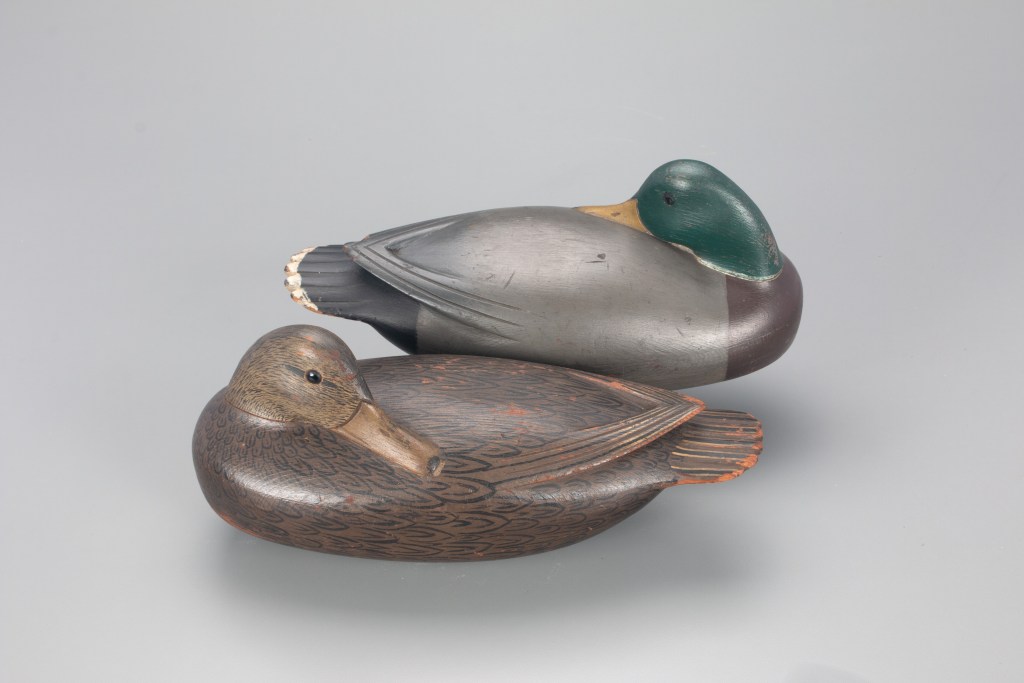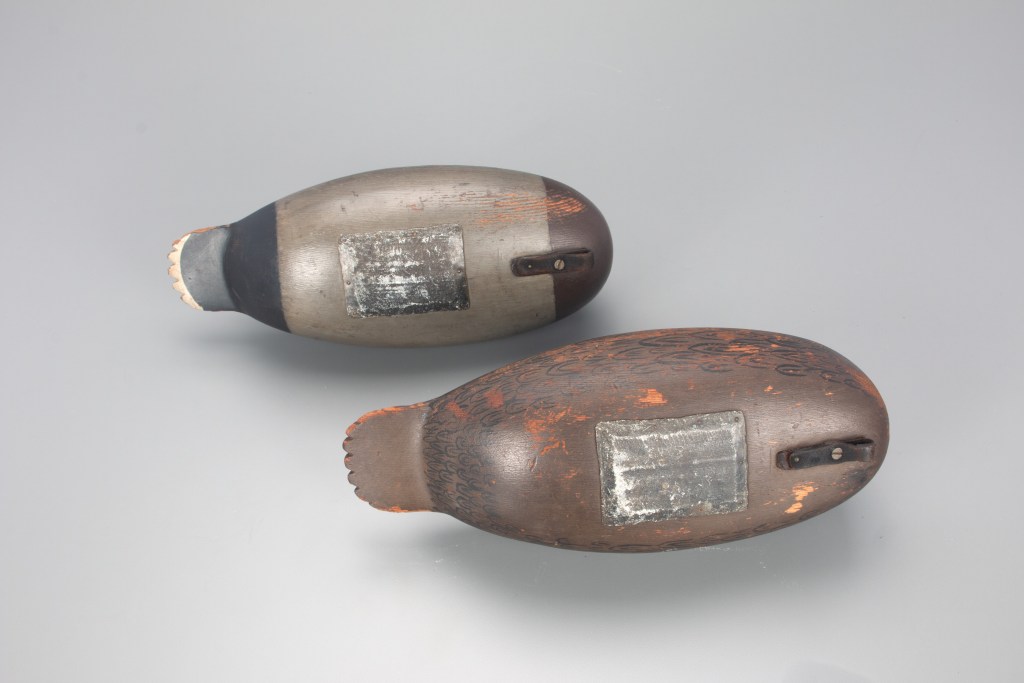
Update: The Jess Heisler pair of sleeping duck decoys sold for $28,800.
What you see: A pair of sleeping mallard duck decoys by Delaware River region carver Jess Heisler around 1920. Copley Fine Art Auctions estimates the pair at $20,000 to $30,000.
The expert: Colin McNair, decoy specialist for Copley Fine Art Auctions.
Who was Jess Heisler? Where was he in his career around 1920, when he made this pair of decoys? Jess Heisler is remembered as one of most competent early decoy makers from the Delaware River region, where he was perhaps the most talented disciple of the early master John English. He lived and worked just south of Trenton, New Jersey. During his life, he was highly regarded not only for decoys but also for exceptional boats, perhaps the region’s finest. I’ve heard he was also skilled with vintage furniture restoration.
How prolific was he? Estimates of his output are between 1,000 and 2,000 decoys. That said, most years only see a small handful of his carvings cross the auction block, really just a few in original condition.
Did Jess Heisler both carve and paint his decoys, or did he only carve? Did he have assistants? Jess was a one-man operation, carving and painting all of his own decoys. This one-man operation is very typical for the Delaware River carvers.
The lot notes describe the Jess Heisler duck decoy pair as “exceedingly rare”. Why? First, they are mallards, which are far less common than his black ducks and other species. Secondly, the sleeping pose. It only seems to appear two or three times in a decade. Third, they are a pair–most of his rigs have been broken down to singles. Capping it off, they are from his golden period, and they survive in virtually ideal condition.

Did Jess Heisler sign his work? If not, how do we know the pair is by him? Like most makers, Heisler did not sign his work. That said, his craftsmanship and nuance of style practically act as a big John Hancock for anyone familiar with the decoys of the mid-Atlantic region. Paired with that, his presence was very much alive when the decoy collecting community began taking notes in the 1950s and 1960s.
Do we know anything about how this pair of Jess Heisler duck decoys came to be—why he might have made it? While we do not know the history of this specific pair, we can make some deductions. I would bet they were made for a wealthy sportsman. This is because they were barely used, they are in a special pose, and they are of an uncommon species.
The Jess Heisler duck decoy pair dates to circa 1920. Do decoys start to become more decorative and less functional around that time? Or would these work perfectly well in the wild? It’s more complex than that. Heisler pretty clearly seems to be going far beyond what was needed in order to impress more than just the ducks. He was trying to impress a wealthy client with those long thin tails, sharp raised wing tips, and that fine featherwork on the hen. So, they were 100 percent honest working decoys that also had the hunter in mind.

Why carve duck decoys that appear to be sleeping? This topic has been the subject of intrigue for as long as decoys have been in play. While we don’t know Heisler’s logic, we do believe that he was the originator of this sleeping pattern. One theory is that resting birds help make the rig [the string of decoys placed on the water] look at ease and invite passing birds. Who knows if that works, but as a hunter, I can assure you it is harder to break a head off of one of these sleeping decoys than a regular decoy.
Do we know how many sleeping duck decoy pairs Jess Heisler did, either of mallards or of any other species of duck? I looked back over a quarter-century of auction reports and this pair represents one half of all known Heissler sleepers. And they are the two finest.
You say Jess Heisler is believed to have invented the sleeping duck decoy form. This pair dates to circa 1920. Does that make it an early Heisler take on the sleeper? If so, does that make the pair more interesting to collectors? Or does the timing not matter? To clarify this point, Heisler did not invent the sleeper in general. Albert Laing is the earliest known maker of sleepers, and his date back to the antebellum period. Heisler appears to have originated this variation of the sleeper. I’d place these in the early to middle golden period of his carving arc, so timing is a factor, and these benefit from that.
Is it rare to see an intact pair of male-female duck decoys, or do pairs tend to stay together through the decades? This Winter Sale catalog has hundreds of single decoys that began their lives in rigs ranging from six to 200-plus birds. Today rig mate pair numbers appear to have just bounced off an all-time low, and the pendulum is swinging back towards the rejoining of pairs and sometimes larger rig groupings, especially with shorebird decoys. I love it. Decoys were intended to be seen en masse.
Does the provenance tell us if this pair has stayed together since they were made? Or were they ever divorced and reunited? The provenance suggests they’ve always been together, which is highly probable in this instance.
What can we tell, just by looking, about how difficult the pair of duck decoys would have been to make? For example, how difficult is it to get the two to look nearly identical, aside from sex-based markings? This is actually a fairly elaborate duo. Having handled and X-rayed these, I can tell you the bodies are made from three joined pieces of wood with watertight body seams. The inside of the body is hollow, which adds layers of work and complexity to the construction. The heads are fitted to the body with a scribe-line inlay around an edge of the bills. From the photos anyone can make out the elaborate and stylish wing tip and tail carvings with some carved feather detail… and then again that hen’s painted feathering! I could go on, but Heisler seems to have casually created a highly complex and functional pair that work perfectly together.
What is the pair of duck decoys like in person? What aspects elude the camera? Their hollow bodies make them super light. Their undersides have chamfered lead pad weights, which allow them to almost hover above a surface. In the hand they have a lovely dry surface. And while one hand embraces a round and compact head and breast the other is literally on edge with the tactile contrast of the wing tips and tail. Our photographer did a great job, but they only get better in person, I assure you.

What is your favorite detail of the pair of Jess Heisler duck decoys? Like any successful sculpture, they only succeed as complete form. With that established… I… I do love Heisler’s exaggerated take on John English’s raised wing-tips and protruding tail.
What condition is the pair in? Do they show signs of having been used by a hunter? They were definitely used, but not too much, and only in freshwater. They have what I consider to be a Goldilocks level of light gunning wear, just enough to build character and tell a story and not so much as to distract.

What is the world auction record for a Jess Heisler duck decoy? According to the Decoy Magazine Year in Review for 2020, the Heisler record is $36,800. That was for a pintail in 2007. This sleeping pair could break that on a good day. We’ll know soon enough. Copley smashed the record for the entire Delaware River region a couple years ago, hammering down a John English decoy at a quarter million, so that helped make some room.

Why will this pair of Jess Heisler duck decoys stick in your memory? Well, for me, decoy memories can be made where excellence meets rarity. To illustrate the rarity–while cataloging, I flipped through every single page of the leading book on the Delaware River region decoys and found exactly zero sleepers like these.
How to bid: The pair of Jess Heisler duck decoys is lot 0121 in The Winter Sale 2021, offered by Copley Fine Art Auctions on February 19 and 20, 2021.
How to subscribe to The Hot Bid: Click the trio of dots at the upper right of this page. You can also follow The Hot Bid on Instagram and follow the author on Twitter.
Images are courtesy of Copley Fine Art Auctions.
Copley Fine Art Auctions is on Twitter and Instagram.
Colin McNair has appeared on The Hot Bid to talk about an Elmer Crowell preening black duck decoy, an Ira Hudson flying black duck, and an Earnest-Gregory dovetailed goose decoy.
Please share this story on social media! It helps The Hot Bid grow.
Quack Quack!
Would you like to hire Sheila Gibson Stoodley for writing or editing work? Click the word “Menu” at the upper right for contact details.